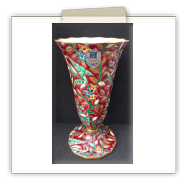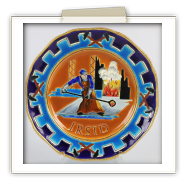(1945 - 1977) From the success to the decline of the Earthenware factory of Longwy with d'Huart
In 1943, Maurice-Paul Chevallier took over the direction of the artistic decoration workshops (a position he had already held before the war), inspired by the privileged themes of Oriental Japanese and Chinese decorations. The reinstatement in the buildings took place at the end of the war in 1945 with an abundant production of enamelled pieces and the hiring of 250 workers.
Have come to the Factory a new generation of artists who will participate in the renewal of the aesthetics of creativity in Longwy while maintaining the desired artistic continuity Maurice-Paul Chevallier. We can mention Louis Valenti, Hélène Gabet, Rolande Rizzi, Paul Mignon who will be awarded "Meilleur Ouvrier de France" in 1965 ... The earthenware market has become a little bearish, only a few table services are still manufactured to abandon production altogether in 1962.
During the end of the 1950's, a new production will be born "earthenware of art" which will not be very good taste mostly for some with the time that passes but which will be the reflection of a time and also a increased productivity and profitability for earthenware. Series enamel decorations will also undergo more simplistic transformations to accelerate the production time, which will be felt in the quality of certain enhancements and drawing cartels. The production of unique works and limited edition when it will continue with always the same quality of the art workshops.
In 1958 the company has only one hundred and sixty workers, it sells part of its premises to the Steel company "Lorraine-Escaut" and destroys the oldest part of its buildings. Between 1964 and 1968, Factory sells the remaining premises in Usinor and transfers its activity in the old castle of the direction where it settles with seventy seven people.
The 1960's saw the arrival of a new artist, Christian Leclercq, who will be awarded "Meilleur Ouvrier de France" in 1972 and who will occupy all the manufacturing positions and leave behind a significant creative work. He will be with Paul Mignon and Louis Valenti the last of the great artists of the old Factory of Longwy.
In 1975, despite efforts to adapt to the market, the company must sell the collections of historical works that will be partially pre-empted by the town of Longwy which will be the basis of the future municipal museum. But this action will not be sufficient and in 1976 the pottery must file for bankruptcy and in 1977 the judicial liquidation is pronounced but other pages of this fabulous story will open ...

















